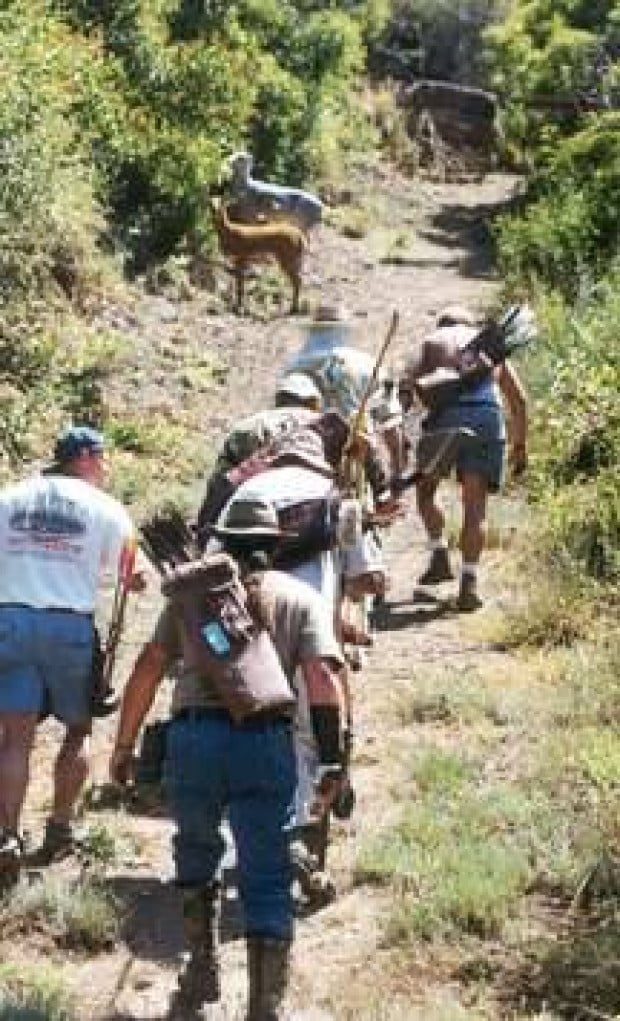There is something empowering about drawing a bow and arrow, aiming, and actually hitting a target. In that single moment, when the arrow hits a paper target or a fake animal target called a 3-D, it somehow doesn’t matter that the cat is out of food, a phone call has not been returned or that the sheets never made it to the dryer. The target is hit, and that can make one feel, well, complete.
Driving up Latigo Canyon Road, about two-and-half miles from Pacific Coast Highway, to the Malibu Mountain Archery Club, the drive is part of the experience. The “city stress” begins to vacate, and, in my case, I am locked in a flashback. I was 9 the last time I had an archery lesson and it wasn’t good–perhaps because the instructors were actually equestrians who were dubbed as archery counselors and were essentially clueless.
I pass the archery club’s gate and begin to smell the earth. I thought of Artemis, goddess of the hunt, always at the ready with her bow and arrow. The story is told that when Artemis was a child her father, Zeus, asked what she wanted as a gift. “I want to run forever,” she replied, “wild and free in the woods with my hounds and never, ever marry!”
It could happen.
I decided that however I fared with the day’s archery lesson, I would keep Artemis in mind.
Founded in 1938, the Malibu Mountain Archery Club is said to be the oldest, continuously operated field range in the United States. It includes a 28-target field course and target distances that vary from 10 to 80 yards. According to the club, “The targets are shot in sequence, similar to a round of golf.” The expansive range includes 50, 3-D animal targets and a 90-meter FITA (Federation Internationale de Tir a L’Arc) target used for Olympic- style archery.
The club, open year round, has a compelling history. During World War II, the club was an “open house” for military men who required lodging, and was frequented, and reportedly honored by Hollywood figures, including archer extraordinaire Howard Hill, child star Shirley Temple and swashbuckling actor Errol Flynn.
While touring the range, I noticed many 3-D animal targets consisting of (fake) deer, pigs, rabbits and others, before meeting one of the club’s fiercely dedicated vice presidents, Ralph Hydle.
Hydle remarks that since my last name is Fletcher (meaning arrow maker), perhaps it’s an omen that I am here. He goes on to say that archery is “a release,” adding, “90 percent of shooting is mental,” and quickly assuring me that “women are better at archery than men” due to their ability to “take instructions well.” I agreed.
Before I began my lesson with club member Debra Ervin, an archery veteran as well as a gold- and bronze-winning medalist in national archery competitions, I was fitted with an arm guard, proper bow for my height, as well as arrows. Ervin was succinct and patient. After showing me the proper form and safe shooting methods, I was good to go. Drawing the bow for the first time, I felt back muscles I didn’t know I had, perhaps because they haven’t been used in a while, but quickly I got used to the feeling. When an arrow is launched and hits a gold ring, it spurs me on.
As the sun lowers on this sultry summer day, I am told I can proceed to the 3-D targets with Hydle and two other club members, Scott Kalter and Ronald Blum–whose enthusiasm for the sport is infectious.
Hydle tells me that some say it’s politically incorrect to even remotely espouse animal target shooting. “I am against it too,” I say. “But I know they’re fake.”
The sizable 3-D targets are deeply nestled in the woods throughout the archery range and part of the fun is finding them. After a trial run and coaching from my now three fans, I hit the first animal target in the neck and feel a huge grin wash over my face. I am told it didn’t leave until long after I had left the range. I hit many targets that day and realized afterward that my archery experience was nothing short of therapeutic.
Little had mattered during those hours except focusing, aiming and going for the bull’s-eye. I am a believer and will return. Who knows, Artemis might have been lurking after all.
The Malibu Mountain Archery Club shoots are scheduled for the fourth Sunday of every month, coupled with a “pot-luck” breakfast or lunch. Lessons are free. The club is located at 5656 Latigo Canyon Road.


